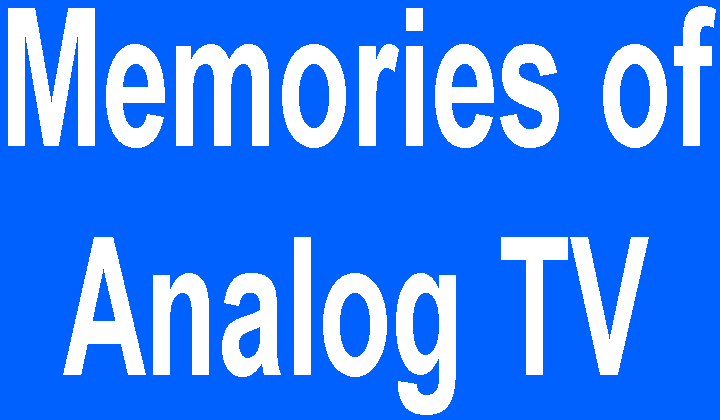 Home
DFS
SB
OD
SDN
DFSM
THP
Donate $5
Home
DFS
SB
OD
SDN
DFSM
THP
Donate $5
KCST (now KNSD) Channel 39 was broadcasting for a short while until going dark in 1967 and resuming in 1968, the year that KEBS (now KPBS) channel 15 signed on as a public TV station.
More on channel 39 at The History of UHF Television: KAAR 39
I'm not sure of the Mission Cable lineup, but I believe that they carried KCET 28 on 12, the Los Angeles VHF channels on the actual dial positions, and channels 6, 8, and 10. KCST still had cable 3 reserved for them while they were off the air. I'm not sure what cable 3 was filled in with while KCST was off the air.
When KEBS and KCST signed on in 1968, KEBS assumed cable channel 12 in place of KCET, which was a Los Angeles public TV station. KCST was back on cable 3. Both of their schedules were from about 4pm-10pm. KCST was independent. KEBS was an affillaite of NET (National Educational Television), which would morph into the current PBS network.
Channel 12 was on from about 4 to 10pm. It was the lone Spanish language station in the Tijuana area at the time.
ABC was on channel 6 in Tijuana, so people who had FM radios in their cars and homes could listen to the audio portion of ABC's programming whereever they were. CBS has been on 8 for the longest time. Channel 10 was an NBC affilliate. In Los Angeles, in the past as well as the present, CBS was on 2, NBC was on 4, and ABC was on 7. 9 was and still is independent. Channels 5, 11, and 13 were all independents.
On Mission Cable, reception of KPBS on cable 12 had some ghosts from XEWT channel 12 leaking into the reception. Viewers closer to Tijuana had it worse. Cable channel 6 had ghosting coming from the broadcast channel 6, so XETV was ghosting its own cable signal.
If you lived in El Cajon valley where reception of 6 and 12 was far more difficult, you didn't get the ghosting.
Mission Cable did, however, repeat XETV's signal on cable channel 7 whenever KABC 7 and XETV 6 had the same programming, so it provided viewers of XETV a cleaner picture on cable 7.
Whenever KNXT (now KCBS) 2 and KFMB 8 had the same CBS programming, cable 2 was replaced with something like a BBS banner saying that this program is blacked out and you need to tune in channel 8 to view it or something like it. Same thing for cable 4 when KNBC 4 and KOGO (now KGTV) 10 had the same NBC programming.
Most TVs didn't yet have the current coaxial connection to hook up cable TV to, so they used a 75 to 300 ohn converter so they can be connected to the TV sets. The 300 ohm connectors are basically two screws that connect the wiring from an antenna (indoor or outdoor) to the TV.
The TV tuners were mechanical, with the VHF dial going from 2-13 and U for UHF. The VHF tuner made a click when you changed the channels. When you turned on "U", you could use the UHF dial, which went from 14 to 83 in the old days. The UHF tuner, unlike the VHF tuner, didn't have stops like the VHF tuner did, so you had to guess where channels 15 and 39 were approximately by spinning the UHF dial until you came over a 14 or a number close to it for channel 15. For 39, you had to spin the dial to where it was approximately, something like between 38 and 44 on the UHF dial. In the 70s, the UHF tuners were click stopped, so you could know better where all of the UHF channels were supposed to be.
For most of us, 13 channels (7 from L.A., 6 from San Diego/Tijuana) were enough. To get XEWT if you had cable, you had to temporarily disconnect the cable so you can view it on 12. You could also get a cleaner KEBS on channel 15 instead of watching it on 12 if XEWT's ghosts were interfering with KEBS's picture there. If you could get XETV in the clear over the air, you could just disconnect the cable and watch it. You could reconnect the cable to watch the Los Angeles VHF stations.
Oh what fun we had in the 60s with analog TV!
2 KNXT 2 (CBS) / blackout notice when KNXT had the same programming as KFMB
3 KCST 39 (IND) (on the air from 4pm-10pm)
4 KNBC 4 (NBC) / blackout notice when KNBC had the same programming as KOGO
5 KTLA 5 (IND)
6 XETV 6 (ABC)
7 KABC 7 (ABC) / XETV was on cable 7 when KABC had the same programming as XETV
8 KFMB 8 (CBS)
9 KHJ 9 (IND)
10 KOGO 10 (NBC)
11 KTTV 11 (IND)
12 KEBS 15 (NET) (on the air from about 4pm-10pm regularily, and longer during school days when it ran instructional TV courses
13 KCOP 13 (IND)
XEWT (IND-Spanish) was broadcasting on VHF 12, but was not carried on Mission Cable yet. It aired from about 4pm-10pm.
Some viewers could get KEYT 3 (ABC) from Santa Barbara. TV Week listed programming for that channel in the San Diego Union.
Also note that in 40 years, the only cable channel hasn't had a station change call letters or
network affilliations, and hasn't hosted a different channel during the entire time is KFMB-TV.
Cable 6 still has XETV, but its affilliation had changed to Independent in 1973 to FOX in 1986 to CW in 2008.
Cable 10 had KGTV changing calls to KOGO, then changing its affilliation to ABC in 1977.
Cable 12 began hosting XEWT the same day KPBS (formerly KEBS, now PBS) moved to cable 11 in 1991.
Cable 13 dropped KCOP (then UPN, now MNT) at the station's request in favor of picking up XHDTV 49 (then UPN, now MNT) in 1999.
Cable 5 got the present KSWB (then WB, was CW in 2006, now Fox in 2008) while KTLA (now CW) moved to cable 14 in 1995.
Cable 7 had TBS for a short while in 1982, then got KCST in 1983 (became NBC in 1977, changed calls to KNSD in 1988.)
Cable 9 got KUSI 51 when it signed on and dropped KHJ in 1982.
Cable 4 is now home of 4SD, a local origination cable channel, in 1997, and lost KNBC due to the station's
demands for payment for carriage on its system in 1993. Cable 4 was also part time home for ITV and the now
defunct Christian Communications Network and Rainbow Channel local cable channels.
Cable 3 has been ESPN since Cox moved KCST to cable 7 in 1983. KCST got ABC in 1973, then NBC in 1977.
Cable 2 has been USA since 1983, moved KNXT to cable 24 for a year, then dropped KNXT.
Anybody got any retro cable channel lineups? Please send them in and I'll publish them.
© 1995-2026. davesfunstuff.com. All Rights Reserved. Reproduction of any part of this website without expressed written consent is prohibited.



